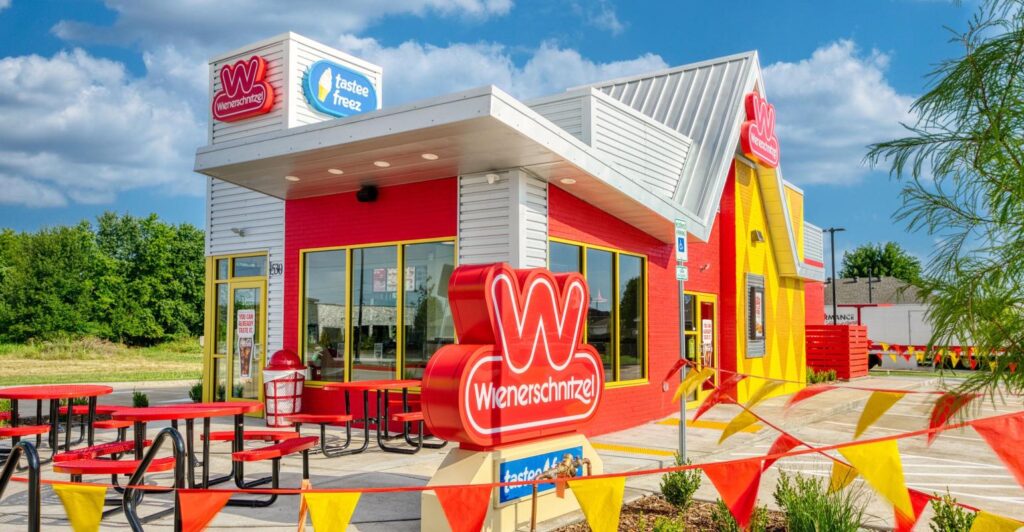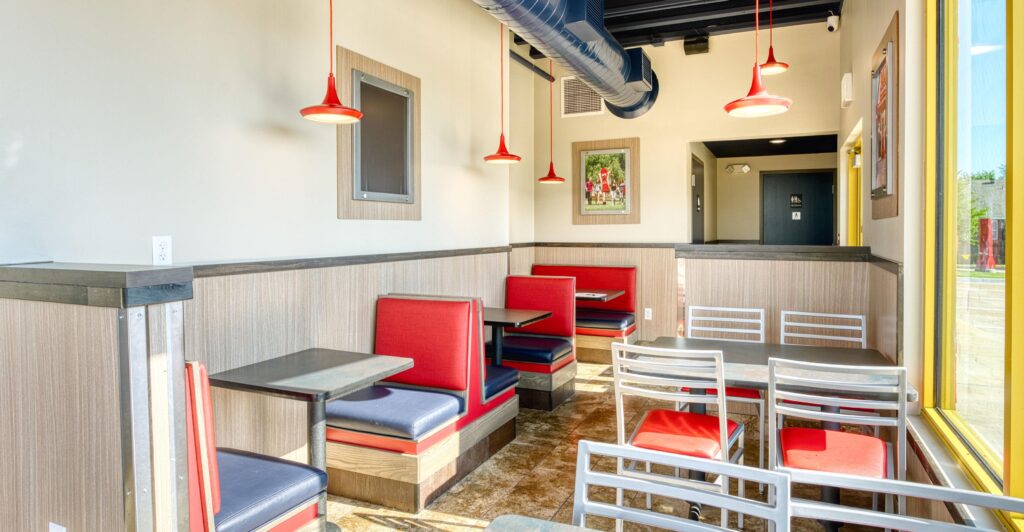Restaurant operators shrink the store,
not the experience
New prototypes cater to the off-premises customer with efficient models for service
01 March 2024
Share this exclusive content from Saladplate

Wienerschnitzel operates multiple formats as small as about 800 square feet
More and more restaurant operators seem to agree: Smaller is better when it comes to new unit prototypes.
As the trend toward off-premises dining settles into a “new normal” that is still well above pre-pandemic levels, the need for seating — and parking — is decreasing accordingly. This presents both opportunities and challenges for operators.
Although smaller formats cost less to build and operate, operators still need to generate enough sales to ensure an adequate return on their reduced investment. That calculation must account for the lower margins on third-party delivery orders, as well as the loss of customers seeking an in-store dining experience, according to operators.
At drive-thru hot dog specialist Wienerschnitzel, for example, the company added indoor seating to its prototype Heritage format as an option after learning that its customers in the Texas market like to have someplace to beat the heat.
“We found out by trial and error that sometimes you need a little bit of a dining room,” said Rusty Bills, chief operating officer at Wienerschnitzel, which tallies about 78% of its business via takeout, including drive thru.
The company has long focused on operating efficiencies in its restaurants, which are known for their compact, A-frame design. Its Heritage prototype preserves elements of that design in a more cost-effective, 820-square-foot format, and its newer Heritage Plus design has added a dining room with space for about 16–20 seats, bumping the square footage up to about 1,200 square feet, which is still compact compared with most quick-service concepts.
Maintaining the experience
Operators are also rethinking their back-of-house operations to optimize efficiency and minimize labor costs without sacrificing service levels or the customer experience for both on- and off-premises dining in their small-format stores.
Chicago-based Portillo’s, for example, is rolling out a smaller store design — 7,700 square feet, with a 65-foot production line — compared with its previous standard of 11,300 square feet with a 105-foot production line. It is also developing what it calls a “restaurant of the future” measuring 5,500–6,000 square feet with a 47-foot production line.

Del Taco recently opened its first off-premises-only location, measuring 1,200 square feet and based on the design of sister brand Jack in the Box
“Our restaurants historically have been big,” said Michael Osanloo, president and CEO of Portillo’s, during the company’s investor day conference last September. “We’ve gotten them to a much more manageable size. We think that we can get them even to a more efficient size without risking revenue.”
He said the company has guardrails in place so that the concept does not shrink to the point where it becomes too small to handle volumes of $10–$12 million. Importantly, he said, the restaurant must be able to provide an enjoyable experience for customers.
“We cannot nickel and dime the guest experience,” he said. “I want them to see food cooking. I want them to see tchotchkes on the walls. I want families with kids taking selfies. It’s still got to be a fun, exciting, invigorating brand.”
Portillo’s has also begun opening drive-thru/takeout-only locations that generate smaller volumes from a reduced footprint. The first opened in Joliet, Ill., in 2022, and additional locations are planned.
Garrett Kern, VP of strategy and culinary, added that such stores will target sales volumes of $6–$8 million, in a footprint that ranges between 3,000 and 3,500 square feet.
“A very key element of this is that this is a mature market strategy,” he said. “This is a fill-in strategy. We want to make sure that people understand the magic of Portillo’s, and they’re using the Portillo’s pickup as more of a convenience play when it’s already part of their normal routine.”
Darrell Hernandez, senior VP at real estate firm CBRE, said he’s increasingly seen this strategy among restaurant chains seeking to alleviate some of the sales pressure on their traditional stores.
“Some of them are fortunate enough that sales in a particular area get to the point where it’s tough on their employees,” he said. “Their peak times are just chaos.”
Rather than open another full-sized traditional location nearby, companies instead are opening a smaller concept focused on off-premises dining, Hernandez said.
“You may have a store the customer wants to hang out and relax and dine in, but then there may be another customer in the same trade area that wants the same product, but just wants it quick and wants to be in and out,” he said.
Off-premises designs
Jack in the Box is also seeking to create highly efficient, small-format locations focused on delivery and takeout only, at both its flagship burger concept and at its Del Taco division. The company is seeking to optimize efficiencies in part by sharing best practices between the two brands.
The company recently opened its first 1,200-square-foot drive-thru/takeout only Del Taco location, for example, leveraging the learnings from the Jack in the Box corporate drive-thru/takeout location in Salt Lake City. Del Taco also has small-format stores inside two casino food courts in Las Vegas and at a travel plaza in Littlefield, Ariz.
Jack in the Box designed the delivery/takeout concept with a kitchen production area dedicated for mobile delivery orders, a spokesperson for the company told NRN.

Wienerschnitzel added seating to its Heritage Plus format to accommodate customers who wanted an indoor dining experience

Source: Nation’s Restaurant News



